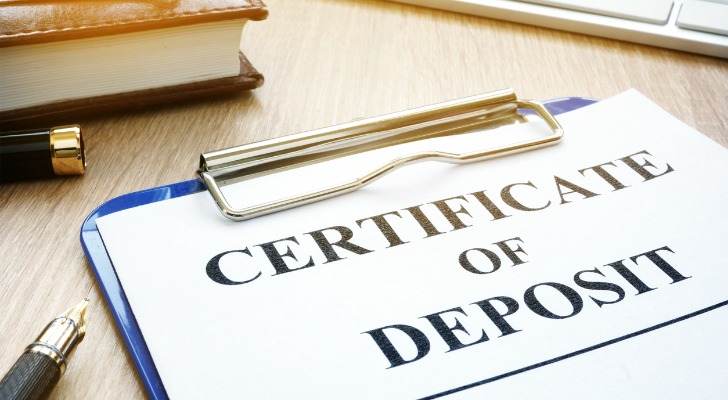Certificates of deposit (CDs) can be a safe and steady way to grow your money with minimal risk. Choosing the right CD lets you match your investment with your timeline and appetite for risk. SmartAsset’s CD calculator can help you determine what a CD could earn based on your initial deposit, the length of the term, its interest rate and how often it compounds.
Do you have questions about how a CD could fit into your overall financial plan? Speak with a financial advisor today.
What Are CDs?
Most banks and credit unions offer CDs as a type of deposit account. CDs allow you to invest a predetermined amount of money for a specific timeframe at a fixed interest rate. When the CD matures, you receive your initial deposit, plus the interest it accrued.
The Federal Deposit Insurance Corporation (FDIC) insures CDs for up to $250,000 per owner, per bank, per account category. In addition to CDs, FDIC insurance covers money held in savings accounts, checking accounts, money market accounts and others.
While the FDIC doesn’t insure CDs at credit unions, the National Credit Union Administration (NCUA) does, providing the same level of protection as the FDIC.
CDs vs. Savings Accounts
CDs and savings accounts both help you grow your money, but they work in different ways. A savings account lets you add or withdraw money freely, making it a flexible option for building an emergency fund or saving for short-term goals. However, that flexibility often comes with lower interest rates.
CDs, by contrast, typically offer higher interest rates in exchange for locking up your money for anywhere between a few months to several years. During that time, you usually can’t access the funds without paying an early withdrawal penalty. The longer the CD term, the higher the interest rate tends to be.
Another key difference is rate stability. With a CD, your rate is fixed for the entire term, while savings account rates can fluctuate depending on market conditions and the bank. If you want to maximize interest and don’t need quick access to your funds, a CD may be the better choice. If access and flexibility matter more, a savings account likely makes more sense.
Types of CDs
As you navigate the world of deposit accounts, you’ll encounter several different types of CDs:
- Traditional CDs: The most common variety, traditional CDs feature a fixed interest rate and maturity date. They usually come in term lengths ranging from one month to five years, though this can vary.
- Bump-up CDs: Designed for rising interest rate scenarios, bump-up CDs let you increase the rate one or more times during the term. For example, you’d purchase a three-year bump-up CD at, say, a 1% APY, but after one year, the bank would raise it to a 1.5% APY. So essentially, they allow you to choose whether to “bump up” your rate to take advantage of the new, higher interest rate. However, there can often be stipulations surrounding this feature, so read the fine print beforehand.
- No-penalty CDs: No-penalty CDs offer more flexible withdrawal options, though they typically offer lower interest rates. Liquid CDs may be better than traditional CDs for investors who need to access their funds on short notice, without facing substantial early withdrawal penalties.
- Callable CDs: Issuing banks hold the power to “call” or redeem these CDs before maturity, potentially leading to reinvestment risk if interest rates decrease.
How to Choose a CD

When selecting a CD, there are several key factors you’ll want to keep in mind, like term length and APY. You’ll also want to consider shopping around for different rates and even think about using a laddering strategy to get the most out of your investment.
Factors to Consider
Reviewing the following factors can help you identify a CD that fits your needs:
- Term length: Align your term with your financial objectives and liquidity demands. Greater interest rates often accompany longer terms, while shorter terms offer more flexibility and liquidity.
- APY: Pursue CDs with higher APYs for enhanced returns.
- Withdrawal penalties: Familiarize yourself with early withdrawal terms at various banks to avoid unexpected charges should you need to pull the money out early.
Short-term CDs with lower APYs may work well for conservative investors looking for a temporary investment. On the flip side, higher-earning, long-term CDs may suit investors who are comfortable with locking in their funds for an extended period.
CD Rates Comparison
As you research various types of CDs to understand their features and benefits, you’ll want to compare interest rates from different financial institutions. SmartAsset’s CD comparison page can help you stay up to date on the current rates and terms that are being offered.
If you’re investing in a CD, you might be unsure which term or rate will yield the highest return. You can use a CD calculator like the one above, which can help you estimate your earnings based on different terms, interest rates and initial deposits. By comparing different CD options, you can make an informed decision.
Building a CD Ladder
CD laddering involves distributing your investments across different CDs with diverse term lengths, balancing both liquidity and high yields. You can tailor a CD ladder to your specific financial situation and goals using the terms available to you at a bank.
For instance, let’s say you open CDs across subsequent terms (1-year, 2-year, 3-year, etc.). This allows you to take some advantage of the long-term rates, while still keeping more liquidity than if you committed everything to a long-term CD. But if you don’t need the funds in your shorter-term CDs when they mature, then you can reinvest that money in a longer CD. Repeat this process as each CD matures to maintain your ladder.
If you’re more focused on short-term savings goals, you can set up a CD ladder with maturity dates every few months. If you have a longer time horizon, you can build a ladder with CDs that mature over the course of several years.
Alternatives to CDs
Investing in CDs may not be the best option to meet your needs, especially if you’re not comfortable locking your money up for a set period of time. Several alternatives to CDs exist, each with its pros and cons.
Here are several alternatives that may suit your goals:
- High-yield savings accounts: High-yield savings accounts enjoy higher interest rates compared to traditional savings accounts, along with easy access to funds. However, rates may change and returns could be lower than CDs, especially in weaker rate environments.
- Interest-bearing checking accounts: While most traditional checking accounts do not earn anything, interest-bearing checking accounts do. However, these accounts likely won’t pay as much as a high-interest savings account or CD and may charge monthly fees.
- Money market accounts: Like high-yield savings accounts, money market accounts benefit from competitive interest rates and FDIC insurance. But they often have minimum balance requirements, limited check-writing capabilities and restricted transactions.
- Investments: Investments, such as stocks, bonds, real estate, mutual funds and other assets, offer the opportunity for higher returns and increased portfolio diversification. However, they’re riskier than CDs and are vulnerable to significant fluctuations in value.
- Annuities: Annuities are insurance contracts that deliver guaranteed income and tax deferral benefits in exchange for a lump sum or series of periodic payments. Just remember that annuities potentially involve costly fees, limited liquidity and are generally suited for retirement income planning.
Frequently Asked Questions
Are CDs Safe?
Yes. CDs at banks are insured by the FDIC up to $250,000 per depositor, per bank, per ownership category. CDs at credit unions receive the same level of protection through the NCUA. As long as your balances stay within coverage limits, your deposits are protected if the institution fails.
Do CDs Compound Interest?
Most CDs compound interest daily or monthly, which increases how much you earn over the full term. Your bank or credit union will disclose the compounding schedule as part of the APY.
How Do CD Interest Rates Compare to Savings Accounts?
Interest rates on CDs tend to be higher since your deposit is committed for a fixed term. Savings accounts provide more flexibility, though their rates may rise or fall over time depending on the bank and broader market trends.
Is a Short-Term or Long-Term CD Better?
Short-term CDs offer more liquidity but generally lower APYs. Long-term CDs typically pay higher rates but require you to keep your money tied up for several years. The better fit depends on your time horizon, cash-flow needs and interest-rate outlook.
Can You Lose Money in a CD?
You cannot lose your principal if your CD is within FDIC or NCUA coverage limits. However, you could lose part of your earnings if you withdraw early and face a penalty.
Bottom Line

A deep understanding of CD options and alternatives is pivotal when looking to maximize your banking experience. Ultimately, when chosen with care and consideration, CDs can provide a reliable and secure return on your investment. However, it’s a very personal choice whether they are the right option for you or not. Using a calculator like this one can go a long way in planning ahead.
Financial Planning Tips
- Investing in an asset like a CD involves lots of factors to consider, from maximizing your return to understanding your appetite for risk. Working with a financial advisor can help you understand what types of investments could work for you. Finding a financial advisor doesn’t have to be hard. SmartAsset’s free tool matches you with vetted financial advisors who serve your area, and you can have a free introductory call with your advisor matches to decide which one you feel is right for you. If you’re ready to find an advisor who can help you achieve your financial goals, get started now.
- Another great tool that can help your choices is to take a look at SmartAsset’s investment return calculator. It can help you understand how your investments can grow over time.
Photo credit: ©iStock.com/designer491, ©iStock.com/Milko
